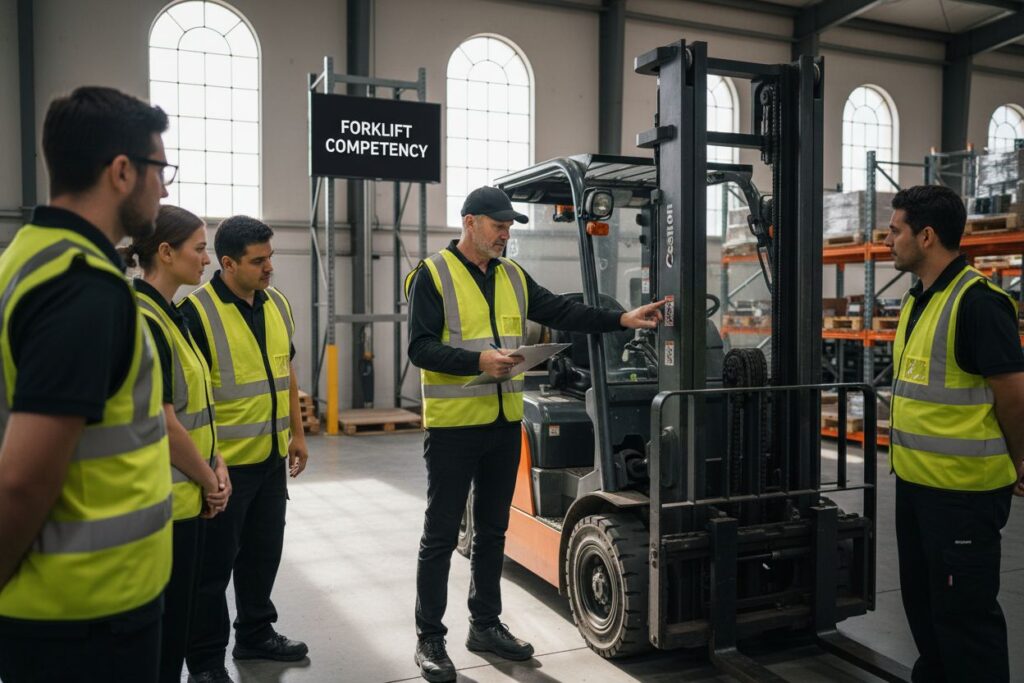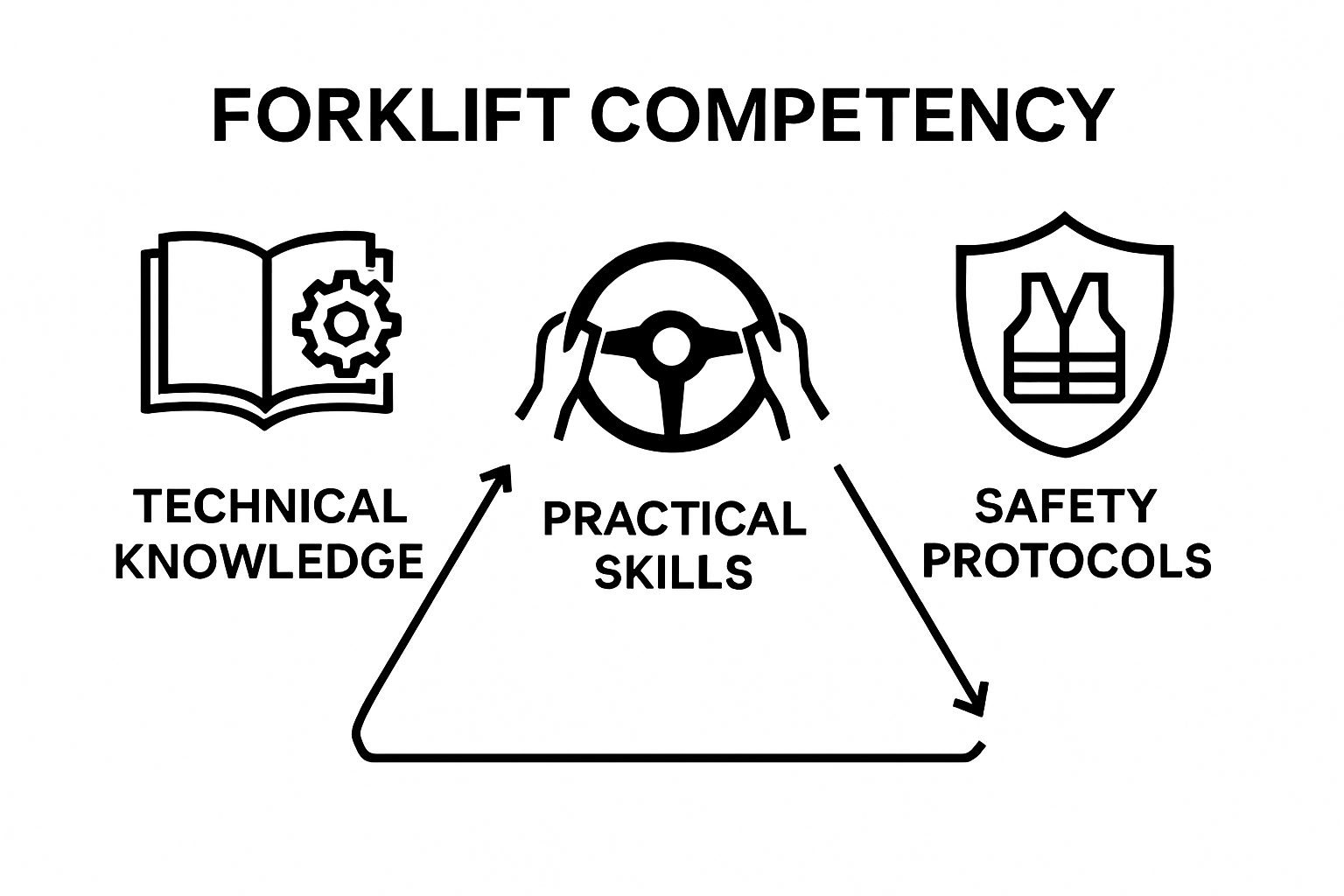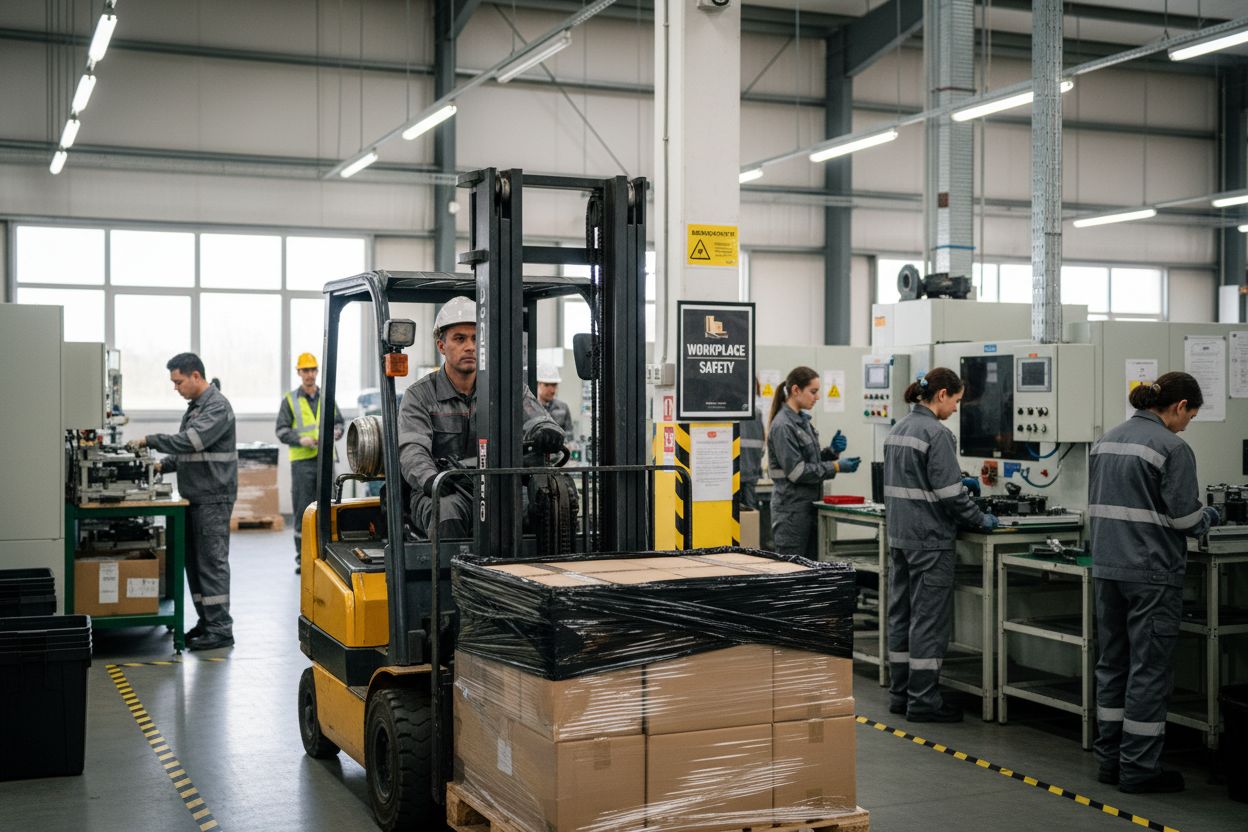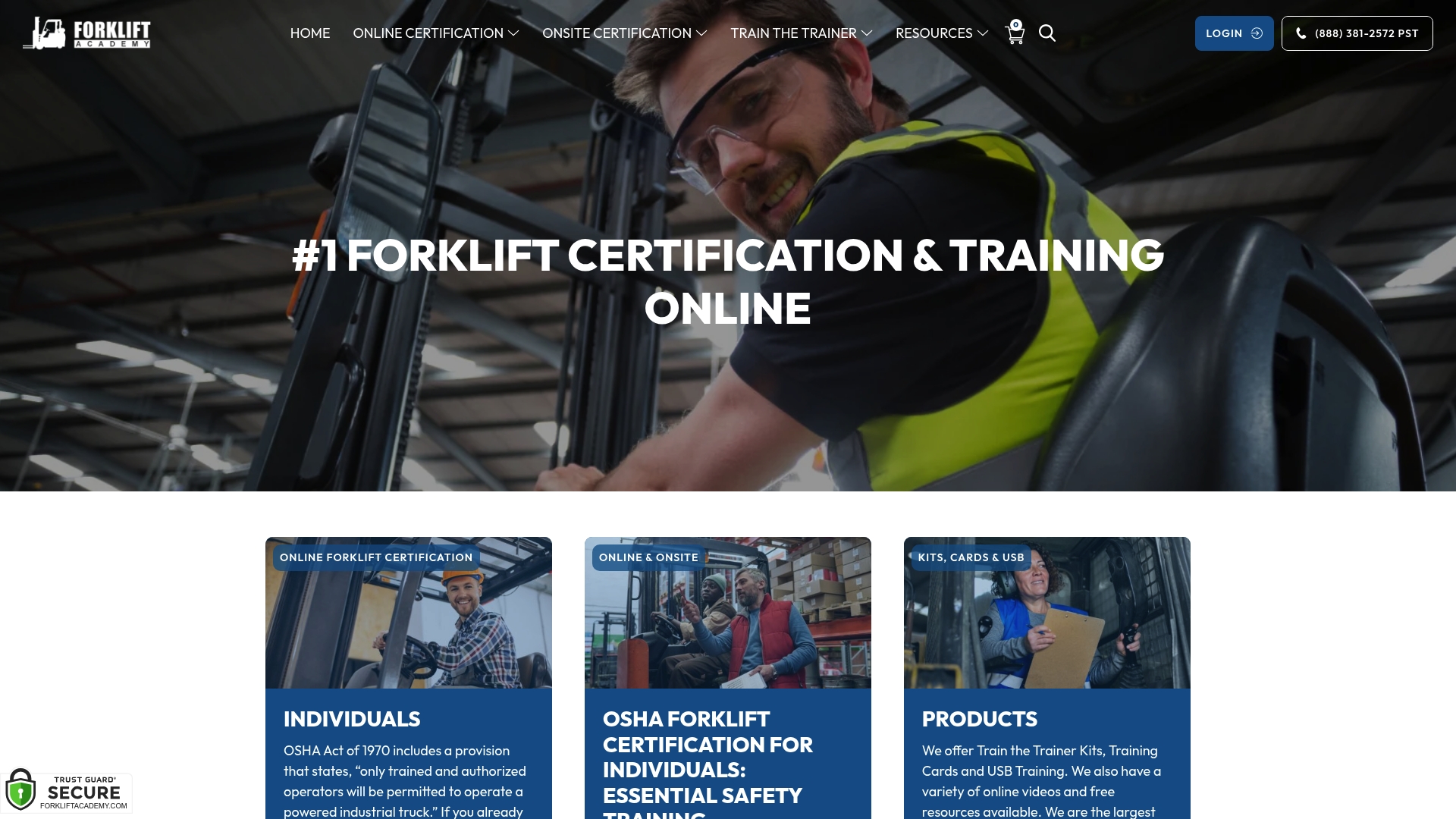
Forklifts are everywhere in warehouses and factories, moving heavy loads with speed most people barely notice. But the real shock is that improper forklift use causes thousands of workplace accidents each year. Training someone to drive is not nearly enough because true forklift competency goes far deeper than knowing where the pedals are.
| Takeaway | Explanation |
|---|---|
| Forklift competency ensures workplace safety. | Operators need thorough training to prevent accidents during forklift operation. The combination of skills and awareness enhances safety. |
| OSHA mandates training and evaluation for operators. | Following OSHA guidelines is essential for legal compliance and maintaining safety standards in forklift operations. Regular evaluations are crucial. |
| Understanding equipment limitations is critical. | Operators must be aware of the specific operational characteristics and restrictions of different forklifts to operate safely and effectively. |
| Incorporate risk management strategies consistently. | Operators should assess potential hazards continuously and implement strategies to mitigate risks while operating forklifts. |
| Competent operators enhance operational efficiency. | Skilled operators increase productivity by managing loads effectively and ensuring smooth operations across various industrial environments. |
Forklift competency represents a comprehensive understanding and practical ability to safely operate industrial lifting equipment in professional settings. At its core, this competency goes beyond merely knowing how to drive a forklift and encompasses a deep comprehension of operational safety, technical skills, and workplace regulations.
Forklift competency is a structured assessment of an operator’s ability to handle complex machinery safely and efficiently. According to the Occupational Safety and Health Administration (OSHA), it involves demonstrating technical knowledge, practical skills, and understanding of critical safety protocols. This competency is not just about driving skills but includes comprehensive awareness of potential workplace hazards, equipment limitations, and risk management strategies.
The significance of forklift competency cannot be overstated. Research from the CDC reveals that improper forklift operation contributes to numerous workplace accidents annually. Competent operators help prevent incidents by understanding:
Moreover, demonstrating forklift competency is not just a recommendation but a legal requirement. OSHA mandates comprehensive training and periodic evaluations to ensure operators maintain high safety standards. Companies that prioritize operator skills training significantly reduce workplace accidents and protect both personnel and organizational assets.
Ultimately, forklift competency represents a critical intersection of technical skill, safety awareness, and professional responsibility. By investing in thorough training and continuous skill development, organizations create safer, more efficient work environments that protect their most valuable resource: their employees.
Forklift competency is a multifaceted skill set that demands comprehensive knowledge and precise technical expertise. Understanding these key components is crucial for creating safe and efficient workplace operations where industrial machinery is utilized.

The foundation of forklift competency begins with robust technical knowledge. According to international safety standards, operators must comprehend complex machinery mechanics, load dynamics, and equipment limitations. This theoretical understanding includes in-depth knowledge of:
Beyond theoretical knowledge, practical skills form the core of forklift competency. Operators must demonstrate precise control, spatial awareness, and adaptability in dynamic workplace environments. Explore detailed operator skill requirements that highlight the complexity of professional forklift operation. Critical practical skills include:
Safety represents the most critical component of forklift competency. Professional operators must integrate comprehensive safety protocols into every aspect of their work. This involves understanding workplace regulations, personal protective equipment requirements, and emergency response strategies. Effective risk management means constantly evaluating potential hazards, maintaining situational awareness, and proactively preventing potential accidents.
Ultimately, forklift competency is not a static skill but a dynamic combination of knowledge, practical ability, and continuous learning.
The following table summarizes the key components of forklift competency, organizing them by category and providing concise descriptions to clarify their role in safe and efficient forklift operation.
| Component Category | Description |
|---|---|
| Technical Knowledge | Understanding forklift types, machinery mechanics, weight distribution, and system fundamentals. |
| Practical Skills | Ability to maneuver equipment precisely, handle loads, navigate spaces, and make quick decisions. |
| Safety Protocols & Risk Mgmt. | Mastery of workplace regulations, PPE usage, emergency responses, and hazard mitigation techniques. |
| Continuous Learning | Ongoing skill development through evaluations and updated training as workplace environments evolve. |
| Professionals who master these components become invaluable assets in industrial and logistics environments, ensuring workplace safety and operational efficiency. |
The Occupational Safety and Health Administration (OSHA) establishes comprehensive guidelines for forklift operator training and certification, designed to ensure workplace safety and minimize potential accidents involving industrial machinery. These requirements represent a critical framework for protecting workers and maintaining operational standards across various industrial environments.
OSHA standard 29 CFR 1910.178 mandates a rigorous training approach that goes beyond basic operational skills. The training program must encompass both theoretical knowledge and practical demonstration of competence. Key mandatory training components include:
Beyond initial training, OSHA requires periodic performance evaluations to ensure continued competency. Our comprehensive guide to forklift operator responsibilities highlights the critical nature of ongoing assessment. Operators must be formally evaluated:
Employers bear significant responsibility in meeting OSHA requirements. This includes maintaining detailed training records, ensuring operators are certified for specific equipment types, and providing a safe working environment. Failure to comply can result in substantial financial penalties and increased workplace risk. Documentation must include:
OSHA requirements are not merely bureaucratic checkboxes but fundamental safety protocols designed to protect workers and create a culture of workplace safety. By understanding and implementing these standards, organizations can significantly reduce workplace accidents and create more secure industrial environments.
This table organizes and compares the main OSHA requirements for forklift operators, highlighting the purpose and outcome of each aspect for better understanding of compliance obligations.
| OSHA Requirement | Purpose | Outcome |
|---|---|---|
| Formal Classroom Instruction | Provide in-depth theoretical knowledge of equipment | Informs operators about safe operation and rules |
| Hands-On Practical Training | Teach real-world operating skills | Ensures ability to control equipment effectively |
| Performance Evaluation | Assess ongoing operator competency | Identifies strengths and training needs |
| Certification Documentation | Maintain legal records of training and authorization | Proves compliance in case of audits or incidents |
| Periodic Re-Evaluation | Monitor long-term operator proficiency | Maintains safety standards and operational quality |
Forklift competency is not merely a technical skill but a critical safety mechanism that directly impacts workplace environments. The relationship between operator expertise and overall safety is profound, creating a protective shield against potential accidents and operational risks.
International workplace safety research demonstrates that competent forklift operators significantly reduce workplace accidents. Comprehensive training transforms operators from potential hazards to safety guardians. Critical risk mitigation strategies include:
Workplace safety transcends physical protection and extends into economic and human resource domains. Learn more about workplace safety considerations that highlight the comprehensive impact of forklift competency. Implications include:
Beyond tangible safety metrics, forklift competency cultivates a broader safety culture within organizations. Competent operators become safety ambassadors, influencing colleagues and establishing workplace norms that prioritize collective well being. This psychological dimension involves creating an environment where safety is not just a requirement but a shared organizational value.
Ultimately, forklift competency represents a holistic approach to workplace safety. It combines technical skill, risk awareness, and a proactive mindset that transforms potential danger into a controlled, secure operational environment. Organizations that invest in comprehensive training and continuous skill development create resilient, safety conscious workplaces that protect their most valuable asset their employees.

Forklift competency extends far beyond theoretical knowledge, serving as a critical operational skill across diverse industrial sectors. Each industry demands unique applications of forklift expertise, transforming operators from equipment users to strategic workplace assets.
In logistics and warehousing, forklift competency directly translates to operational efficiency. Explore the comprehensive guide to forklift types that highlights the complexity of equipment selection and operation. Critical applications in this sector include:
Manufacturing industries rely on forklift operators as integral components of production workflows. Competent operators understand not just equipment operation but also the intricate dynamics of production environments. Key manufacturing applications involve:
Certain industries require advanced forklift competency that goes beyond standard operational skills. Specialized sectors such as construction, maritime shipping, and automotive manufacturing demand extraordinary precision and adaptability. Unique competency requirements include:
Forklift competency represents more than technical skill it is a comprehensive understanding of workplace dynamics, safety protocols, and operational strategies. Professionals who master these competencies become invaluable assets, transforming potential workplace challenges into seamless, efficient operations across multiple industrial landscapes.
Understanding forklift competency is essential when the safety and well-being of your employees is on the line. Many companies struggle with meeting OSHA requirements and ensuring that every operator understands both technical skills and vital safety protocols. If your goal is to prevent workplace accidents and foster a culture of safety, mastering forklift competency is not just important, it is absolutely necessary. Dive deeper into targeted forklift safety solutions that can help you address these ongoing challenges.

Do not let uncertainty around operator skills or regulatory compliance put your people or business at risk. Take decisive action today by exploring proven forklift certification and training programs at ForkliftAcademy.com. Our OSHA-compliant courses and hands-on options make it easy to equip your team with the skills needed for a safer workplace. Whether you need up-to-date forklift licenses or in-depth safety resources, now is the time to build a safer, more efficient operation. Visit us and see how simple it is to get started.
Forklift competency refers to the comprehensive understanding and practical ability to safely operate industrial lifting equipment, which includes knowledge of safety protocols, technical skills, and workplace regulations.
Forklift competency is crucial for workplace safety as it helps prevent accidents by ensuring operators understand load handling, equipment inspection, and emergency response protocols, ultimately reducing risks and enhancing safety culture.
The key components of forklift competency include technical knowledge of machinery, practical skills for operational proficiency, and an understanding of safety protocols and risk management strategies.
OSHA requires forklift operators to undergo rigorous training that includes formal classroom instruction, hands-on practical training, and periodic performance evaluations to ensure they maintain competency and safe operating practices.